One of the cutting edge aircraft of the late 1930s, The Hawker Hurricane was the first British monoplane with semi-monocoque construction (All the structural strength was carried internally. That means no external bracing wires.), retractable landing gear and fully enclosed cockpit.
After the jump, we’ll discuss this key British fighter from the very start of World War II.
Its hard to overstate the importance of this aircraft to the combat effort of Great Britain in the first years of the war. The Spitfire will always be better known, it was the next step of the technology, it was the plane that could face the Luftwaffe’s best on equal terms. But the Spitfire was so cutting edge, British industry struggled to mass produce the type. The Hurricane’s greatest strength may have been that it was slightly less state of the art. The rear fuselage and control surfaces were traditional fabric on frame construction, and the shapes were simpler, with more strait lines. This made construction and repair easier using an existing skilled workforce.
This translated into far more Hurricanes being available to face German expansion. In the first months of the war, Spitfires were hoarded at home, while Hurricanes deployed into combat. When the rest of Europe had fallen, and Britain stood alone against Nazism in that Summer of 1940, Hurricanes still made up almost 70% of British Fighter Command. In the Battle of Britain, Hurricanes would go after German Bombers while Spitfires went after the fighter cover. This proved to be a highly effective division of labor, the faster Spitfires against the faster Messerschmitts; while the Hurricanes, with their hardier construction and more stable gunnery were well suited for braving the defensive fire of a bomber formation and getting more shots into a big fat target. In the end, Hurricanes would account for almost 60% of all RAF kills in that battle. Hurricanes remained an important, if diminishing, part of British air power around the globe until 1943.
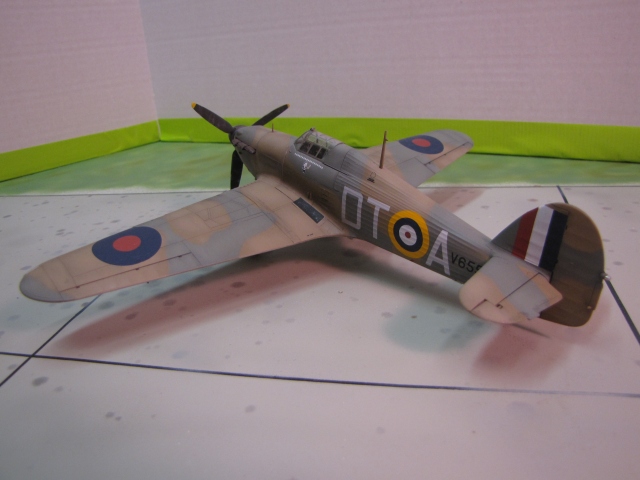
You can clearly see the point aft of the cockpit where the rear fuselage switches to fabric over aluminum.
This particular subject was flown by Squadron Leader Robert Stanford Tuck of 257 Squadron. He started the war as a Spitfire pilot, but transferred to take command of 257 squadron at the height of the Battle of Britain. He would become one of the top aces of that battle, and one of the top Hurricane aces of the war, before transferring back to Spitfires. In 1942 he was shot down on a fighter sweep over France, and finished out the war as a guest of the Luftwaffe. I highly recommend his biography “Fly For Your Life” by Larry Forrester.
This is from the Hasegawa kit, with Aeromaster decals.

Robert Stanford Tuck retired as a Wing Commander. His final score stands at 30.
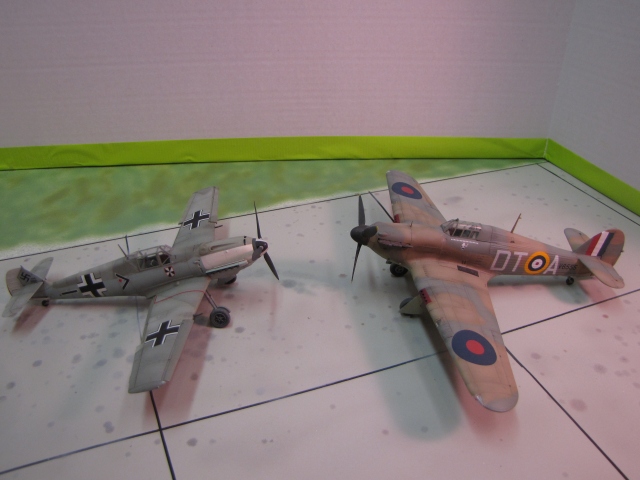
Battle of Britain rivals. Notice the size difference. Both aircraft had roughly the same power. The Messerschmitt was faster and better at altitude. The Hurricane more stable, more robust and more maneuverable.
~ coming next: Seversky J9

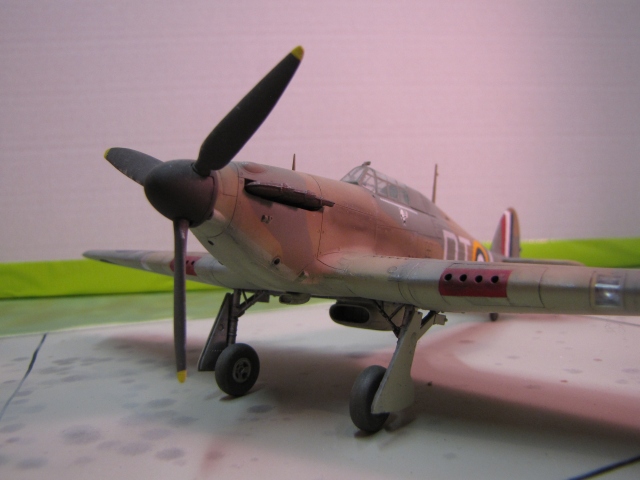

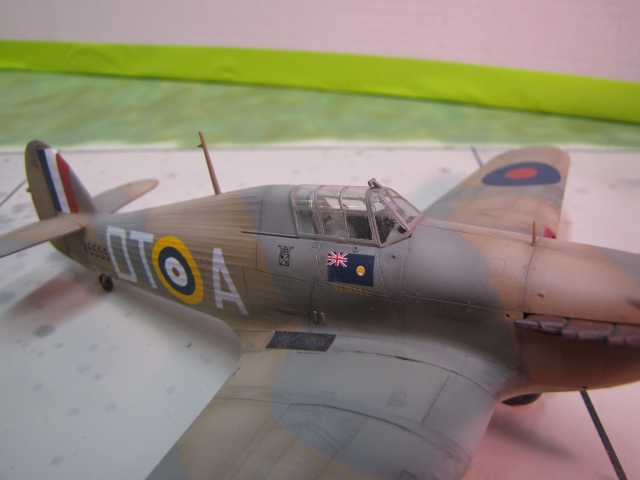
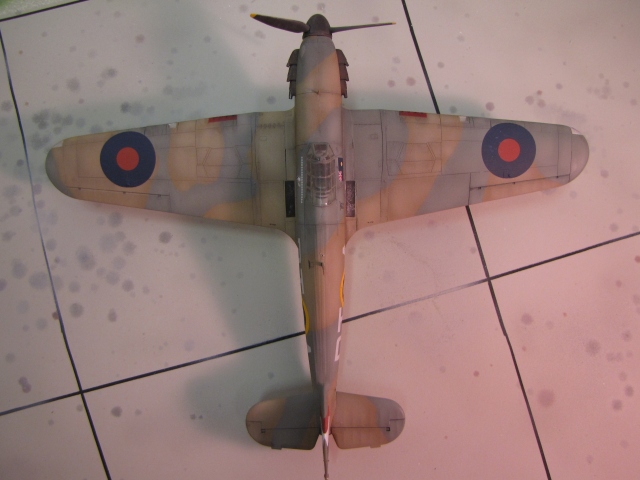
Hurricane was the plane which the bulk of the early war was used.
Yeah it was VERY important until late 1941.
I always thought the Hurricane’s reputation suffered the same way the B-24 did. Even though both bore the bulk of the mission in their time they were never as revered as their rival planes, the Spitfire and the B-17.
Yeah, I think there was definitely some of that. Like the B-24, the Hurricane looks less attractive to most viewers, and it just never generated the same sort of excitement or attention from the press. But even more than the B-24 v B-17, the Hurricane really was inferior to the Spitfire. Not in every way, or even by a huge margin, but there’s no doubt the Spitfire was the better weapon.
The Spitfire was a newer design (by about a year, but in the ’30s and ’40s, a year was a big deal!). It was more advanced and sophisticated; and in particular, it was faster and had better thrust to weight numbers (same engine, but the Spit was lighter!).
As I mentioned in the post, that extra sophistication of the Spitfire caused British manufacturers (Supermarine and it’s suppliers in this case) some real problems, especially just getting production up to speed. So there’s no doubt, the Hurricane’s more traditional construction played a big part in its availability and usefulness in the first couple years of the war. In fact, funny thing, the pre-war Hurricanes had even had fabric covered wings. As the war started Hawker was switching over to an all aluminum wing that made the type a little faster and stronger. So the Hurricane was also being modernized and improved, yet it remained a slightly more cautious design than the Spitfire.
I think the relationship between Hurricane and Spitfire proved to be very complimentary. The Hurricane was a capable enough airplane to provide the RAF’s bulk numbers. While the Spitfire was a world class combatant, equaled in all the world only by the Bf109.
It does seem sometimes like the Hurricane gets overlooked and under appreciated. If anything, those pilots who faced the Luftwaffe in Hurricanes deserve an extra measure of respect. Especially since so many top RAF aces scored most or all of their kills in the Hurricane.
Certainly the Spitfire did earn it’s reputation, and I agree, the Hurricane was a more cautious design. But then most of the allies entered the war with slightly out-of-date aircraft. I usually consider the P-40 to be the US equivalent of the Hurricane, an excellent aircraft for 1939-1941, but as you say, aircraft development in that period was happening at a breakneck pace and it had to be quickly replaced by newer models once it started encountering more modern Japanese and German designs.
I think that’s a fair assessment of the P-40. Although more than the Hurricane, the P-40 had a few pilots who swore by it (I think every Hurricane pilot wanted to be a Spitfire pilot!). I know several of the desert aces felt strongly that the P-40 was better than the Bf109 on the deck (same speed, more maneuverable, more rugged, better firepower). So as long as they were doing close support, or low fighter sweeps, the P-40 was an outstanding mount. But it really was undone by that engine. It just couldn’t breath above 10000′, which just guaranteed it could only be a second string aircraft.
There’s no doubt the US was behind the power curve going in to the war. Some of that was probably unavoidable, it’s very difficult for a non-combatant to keep up with all the wartime developments of the countries actually fighting. But as a major international arms supplier, we were pretty good shape. Especially with the R-2800 engine, and all the aircraft it would power, well along in development.
And I think the Zero was more of an unexpected surprise than a deep threat. No doubt it was an excellent design, but it achieved incredible maneuverability and range at the cost of durability and survivability. Once allied pilots were able to look at it as a tactical and engineering challenge, and not just dark magic, the Zero was manageable. I remember reading a comparison of Zero v Wildcat a few years back, with commentary by both US and Japanese pilots, and although everyone agreed that the Zero was superior in most traditional measures, all of the US pilots said they’d rather be in the Wildcat instead of the Zero. And the Japanese pilots wanted their Zeros…
One big advantage the US had in it’s aircraft was the rugged survivability of so many of them. Not just the carrier planes, but the P-47, the B-17, etc. For the Japanese especially losing experienced pilots became a major problem as the war went on.
It is interesting how often the strengths of much of our military hardware came down to the reliability and durability of their engines.
It is funny how pilots can recognize the strengths of other planes but still prefer their own. I recall a British pilot who said something like there was no plane he’d want to be in a dogfight in other than the Spitfire, unless he was over Germany, then he’d want a Mustang.
Now that I think of it, even the Sherman tank had an aircraft engine.
Especially the American radial engines were first rate, and I think the R-2800 was one of the best engines ever made.
All of the best aircraft have very loyal users. I think too, it’s a major indicator of a problem when pilots don’t believe in their own equipment. In US use, that would especially be the Airacobra and Buffalo.
The one I really love is the Dauntless. Navy and Marine crews swore by it, and loved the machine. Yet the same plane with the Army Air Force, as the A-24 Banshee, was generally despised by its crews. But I think there was a huge doctrinal problem with how they were trying to use it.
The Navy certainly developed the tactics to take advantage of the Dauntless’ strengths. The Army could fulfill the role of close air support with much faster, less vulnerable fighter-bombers, as they did with great success in Europe.
The great strength of the Dauntless was it’s stability in even the steepest of dives. Even as ships were maneuvering to avoid torpedo attacks the Dauntless could come in from above and still put bombs on target.
I think also that the Navy just expected that any sort of bomber needed fighter support to be at its best. And of course, carrier based squadrons always shared their “airfield” with a balanced air group. While the Air Force was enamored of the idea of close support aircraft not needing fighter cover. That worked out very poorly for dive bomber squadrons.
So yeah, the fighter bomber, or fast light attack types like the A-20 or A-36 fit Air Force doctrine much better.
With the type of light bombers the Navy was forced to use (determined by what could fit on an aircraft carrier) accuracy was of the greatest premium. So a precision weapon like the Dauntless was perfect for them. And the burden of protecting it was just accepted.
I’d say that is extremely well put. The operational environment had a huge impact on the tactics.
What’s funny to me is how in most war games it’s almost impossible to use A-24s as poorly as they really were used. The most complicated air combat system I’ve see (Matrix Game’s Pacific War; Admiral’s Edition) rates air crew by air-to-air or bombing proficiency. They need to say Crew A is highly proficient in level bombing and formation flying; Crew B is proficient in Glide Bombing and Helldiving; Crew C is proficient in torpedo and skip bombing….
In my dreams…
While both the Spitfire and Hurricane have both earned thier place in history, comparing them is not fair to either aircraft.
The Spitfire was a thoroughbred and the Hurricane was a draft horse.
Personally, I never get tired of the beauty of a Clydesdale!
Well put! They were very different machines.